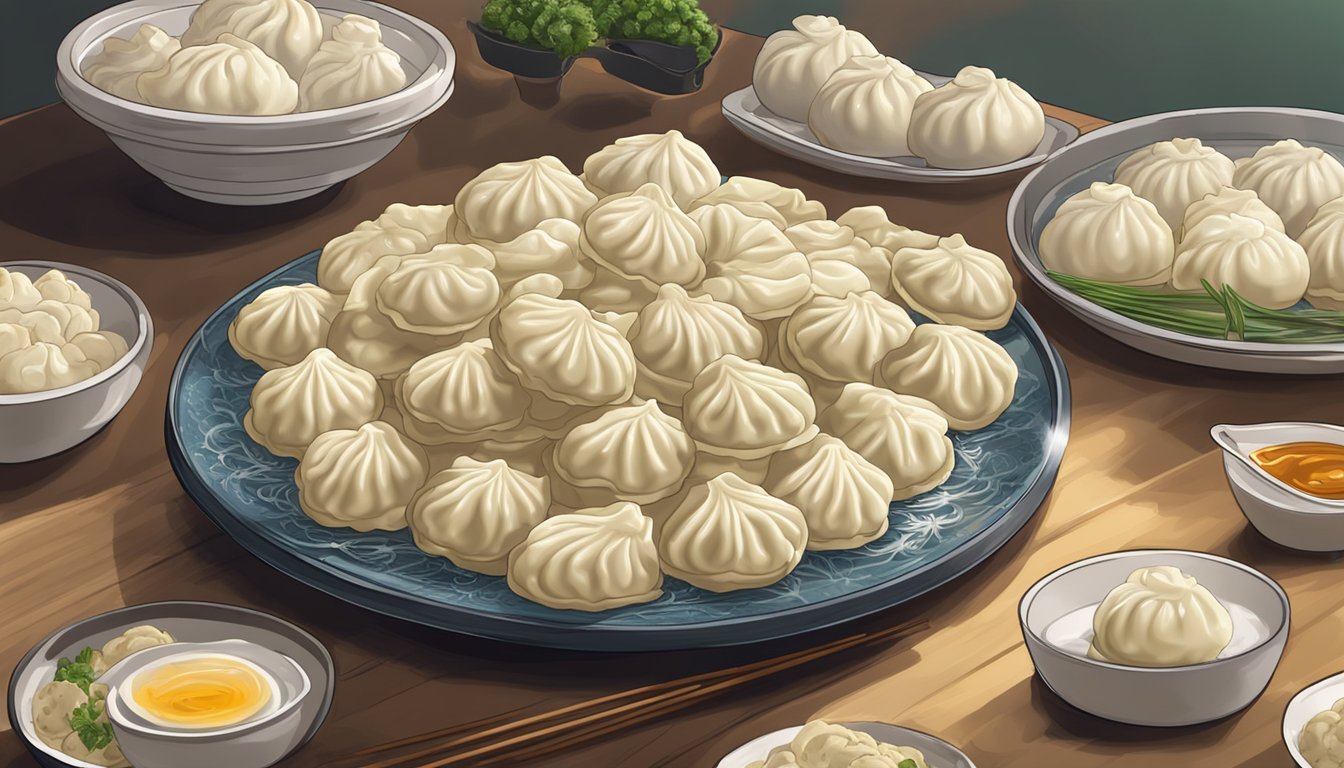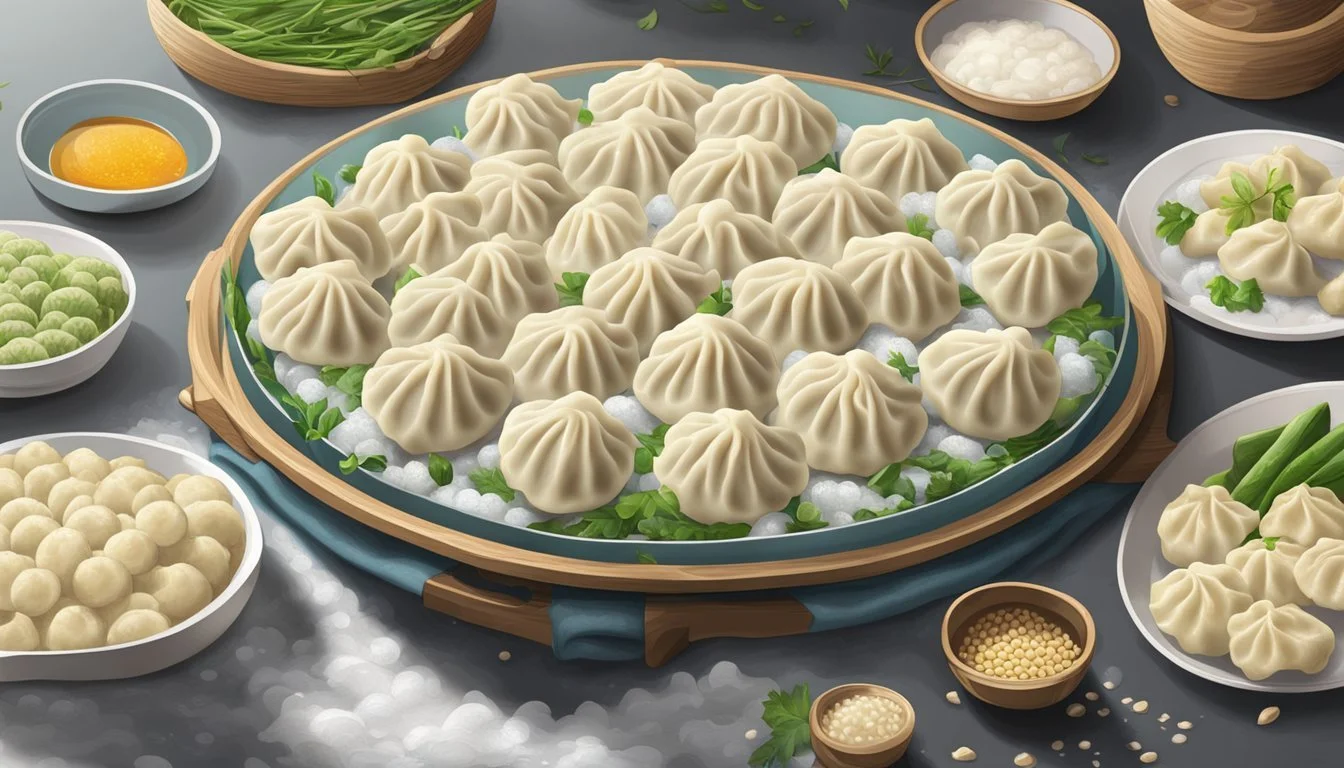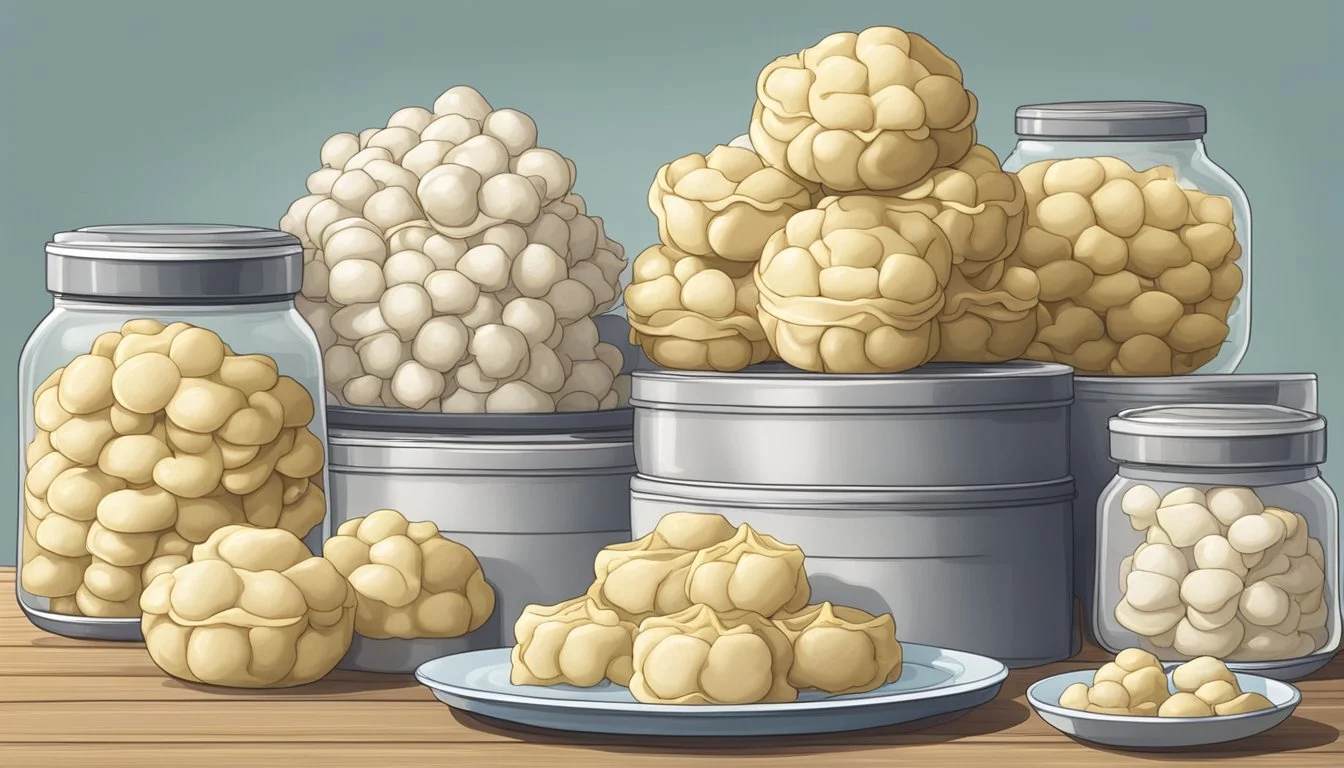Frozen vs Fresh Dumplings: Which Offers the Better Bite?
Dumplings are a beloved comfort food enjoyed across many cultures. Whether steamed, fried, or boiled, these little pockets of flavor bring joy to countless meals. When it comes to preparing dumplings at home, many face the choice between frozen and fresh options.
Frozen dumplings offer convenience and accessibility, allowing for quick meals with minimal prep time. Popular brands like Bibigo and P.F. Chang's provide tasty options that can be cooked directly from the freezer. Fresh dumplings, on the other hand, boast superior texture and customizable fillings but require more time and effort to prepare.
Both frozen and fresh dumplings have their place in the kitchen. Frozen varieties shine in busy households or for impromptu gatherings, while fresh dumplings are ideal for special occasions or when time allows for a more hands-on culinary experience. The choice ultimately depends on individual preferences, time constraints, and desired outcomes.
Understanding Dumplings
Dumplings are versatile pockets of dough filled with savory or sweet ingredients. These bite-sized delights showcase culinary traditions across cultures, featuring diverse shapes, fillings, and cooking methods.
History and Types
Dumplings trace their origins to ancient China over 1,800 years ago. Chinese jiaozi, crescent-shaped dumplings, inspired variations like Japanese gyoza and Korean mandu. In Eastern Europe, pelmeni emerged as meat-filled dumplings popular in Russia.
Dim sum, a Cantonese tradition, features an array of small dishes including various dumpling types. Bao, or steamed buns, offer a fluffier alternative with enclosed fillings.
Shapes and preparation methods vary widely. Some dumplings are boiled, others pan-fried or steamed. Pleated, crimped, or simply folded, each style reflects regional preferences and culinary techniques.
Common Fillings
Dumpling fillings span a wide range of ingredients, catering to diverse tastes and dietary preferences. Meat fillings often include pork, chicken, or beef, typically mixed with vegetables and seasonings.
Vegetarian options feature combinations of mushrooms, tofu, cabbage, and carrots. Seafood dumplings incorporate shrimp, fish, or crab meat.
Common aromatics include ginger, garlic, and green onions. Seasonings vary by region, with soy sauce, sesame oil, and various spices enhancing flavors.
Sweet dumplings, found in many cultures, may contain fruit, red bean paste, or sweet potato fillings.
Cultural Significance
Dumplings hold deep cultural importance in many societies. In China, jiaozi are traditionally eaten during Lunar New Year celebrations, symbolizing wealth and good fortune.
Japanese gyoza are popular street food and restaurant staples. Russian pelmeni are often prepared in large batches, frozen, and shared with family and friends.
Dumplings feature prominently in social gatherings, fostering communal cooking and dining experiences. The act of making dumplings together is often seen as a bonding activity.
In many Asian cultures, dumplings represent unity and family togetherness. Their presence in various festivals and ceremonies underscores their cultural significance beyond mere sustenance.
Frozen Dumplings Overview
Frozen dumplings offer a convenient way to enjoy these popular treats at home. They provide consistent quality and extended shelf life compared to fresh versions, making them a staple in many freezers.
Manufacturing Process
Frozen dumplings are mass-produced in factories using specialized equipment. The process begins with preparing the fillings and wrappers. Machines then portion and wrap the fillings. The formed dumplings are quickly frozen using blast freezers or liquid nitrogen.
This rapid freezing helps preserve texture and flavor. Quality control measures ensure uniformity and food safety standards are met. The frozen dumplings are then packaged and distributed to grocery stores.
Convenience and Storage
Frozen dumplings are prized for their convenience. They can be stored in the freezer for several months without losing quality. This long shelf life reduces food waste and allows for bulk purchasing.
Cooking frozen dumplings is simple. They can be boiled, steamed, or pan-fried directly from frozen. This makes them ideal for quick meals or snacks. Many brands offer microwaveable options for even faster preparation.
Freezing Impact on Quality
The freezing process can affect dumpling quality, but advancements in technology have minimized negative impacts. Flash-freezing helps preserve the texture of both the wrapper and filling.
Some moisture loss may occur during freezing, potentially affecting the juiciness of the filling. However, proper storage in airtight packaging helps mitigate this issue. The flavors of frozen dumplings are generally well-preserved, though they may not be as vibrant as freshly made versions.
Texture changes are most noticeable in the wrapper, which can become slightly tougher. Cooking methods like pan-frying can help restore a crisp exterior.
Fresh Dumplings Overview
Fresh dumplings offer an unparalleled culinary experience with their superior texture and flavor. They allow for customization and provide a hands-on cooking process that many find rewarding.
Preparing from Scratch
Making fresh dumplings starts with creating the dough. Mix flour and water to form a smooth, elastic consistency. Roll the dough into thin circles for wrappers.
For the filling, combine ground meat, finely chopped vegetables, and seasonings. Napa cabbage is a popular choice, adding moisture and crunch. Squeeze excess water from cabbage leaves before mixing.
Placing a small amount of filling in the center of each wrapper, fold and seal the edges to form the dumpling shape. This process allows for creativity in dumpling styles and sizes.
Freshness and Taste
Fresh dumplings boast a delicate texture with tender wrappers that perfectly complement the filling. The dough remains moist and pliable, creating a pleasing mouthfeel when cooked.
The flavors in fresh dumplings are vibrant and distinct. Each ingredient shines through, from the savory meat to the crisp vegetables. The ability to adjust seasoning on the spot ensures optimal taste.
Cooking methods for fresh dumplings include boiling, steaming, and pan-frying. Each technique brings out different qualities in the dumplings, from silky smoothness to crispy bottoms.
Fresh dumplings can be prepared in batches and frozen for later use, maintaining much of their quality when properly stored.
Cooking Methods Compared
Dumplings can be prepared using various techniques, each impacting their texture and flavor. Different cooking methods suit fresh and frozen dumplings, offering versatility in preparation.
Boiling Methods
Boiling is a simple and effective way to cook dumplings. Add dumplings to a pot of boiling water, stirring gently to prevent sticking. Fresh dumplings typically cook in 3-4 minutes, while frozen ones may take 6-8 minutes. Look for them to float to the surface as a sign of doneness.
For a twist, try the "crispy skirt" method. After boiling, create a slurry of water and flour. Pour it into a hot pan, then add the boiled dumplings. As the water evaporates, a crispy lattice forms, connecting the dumplings.
Steaming Techniques
Steaming preserves the delicate texture of dumpling wrappers. Use a bamboo steamer or a metal steamer basket lined with parchment paper. Arrange dumplings with space between them to prevent sticking.
Steam fresh dumplings for 6-8 minutes, frozen for 8-10 minutes. Check for translucent wrappers and firm filling to ensure they're fully cooked. Steaming works well for both fresh and frozen dumplings, maintaining their shape and moisture content.
Pan-Frying Practices
Pan-frying, also known as "potstickers," creates a crispy bottom and tender top. Heat oil in a non-stick pan over medium heat. Place dumplings flat-side down and cook until golden brown, about 2-3 minutes.
Add water to cover the bottom third of the dumplings, then cover with a lid. Steam for 3-4 minutes for fresh, 5-7 for frozen. Remove the lid and cook until water evaporates and bottoms re-crisp.
Alternative Cooking Methods
Air fryers offer a healthier alternative to traditional frying. Preheat to 375°F (190°C), lightly oil dumplings, and cook for 8-10 minutes, shaking halfway through. This method works best for pre-cooked frozen dumplings.
Microwaving is quick but may result in softer textures. Place dumplings in a microwave-safe bowl with water. Cover and cook on high for 3 minutes for fresh, 5 minutes for frozen. Let stand for 1 minute before serving.
Steam-frying combines steaming and pan-frying. Heat oil in a pan, add dumplings, then water. Cover and cook until water evaporates. Continue cooking uncovered until bottoms are crispy. This method balances crispy and tender textures.
Optimizing Frozen Dumpling Preparation
Proper preparation techniques can elevate frozen dumplings to restaurant-quality meals. With the right approach, you can achieve crispy exteriors and flavorful fillings that rival fresh dumplings.
Defrosting Techniques
Frozen dumplings don't always require defrosting before cooking. For steam-frying, place them directly in a preheated pan with oil. This method creates a crispy bottom while steaming the top.
For boiling or steaming, a quick 10-15 minute thaw at room temperature can ensure even cooking. Avoid using the microwave, as it can partially cook the dumplings and lead to uneven texture.
If time allows, transfer frozen dumplings to the refrigerator for a few hours or overnight. This gradual thawing preserves the integrity of the wrapper and filling.
Maximizing Flavor and Texture
To achieve crispy dumplings, use the steam-fry method. Heat oil in a non-stick pan over medium heat. Add dumplings in a single layer and cook until golden brown on the bottom, about 2 minutes.
Pour in 1/4 cup of water, cover the pan, and steam for 3-5 minutes. Remove the lid and continue cooking until water evaporates and bottoms re-crisp.
Enhance flavor by preparing a dipping sauce. Mix soy sauce, rice vinegar, sesame oil, and chopped scallions. For added depth, include minced garlic or ginger.
Experiment with different cooking oils. Sesame oil imparts a nutty flavor, while peanut oil offers a higher smoke point for extra-crispy results.
Serving and Presentation
Proper serving and presentation can elevate the dumpling dining experience. The right accompaniments and plating techniques enhance flavors and visual appeal.
Accompaniments and Dipping Sauces
Dipping sauces are essential for both frozen and fresh dumplings. Soy sauce is a classic choice, often mixed with rice vinegar and sesame oil. Chili oil adds heat and complexity. For a tangy kick, try a mixture of black vinegar and ginger.
Frozen dumplings benefit from vibrant dips to counteract any loss of flavor during freezing. Fresh dumplings pair well with lighter sauces that don't overpower their delicate taste.
Serve dumplings alongside small dishes of various sauces, allowing diners to customize their experience. Include chopped scallions, minced garlic, and crushed peanuts as optional toppings.
Plating Techniques
Arrange dumplings in neat rows or circular patterns on plates or bamboo steamers. For pan-fried dumplings, present them crispy side up to showcase the golden-brown exterior.
Use contrasting colors to make dumplings stand out. Place them on beds of shredded cabbage or lettuce for a fresh touch. Garnish with microgreens or cilantro sprigs for added visual interest.
For soup dumplings, serve in individual spoons or small bowls. Provide larger soup spoons for easy eating. When serving multiple varieties, use different shaped plates to distinguish between types.
Consider temperature contrast by pairing hot dumplings with cool cucumber slices or pickled vegetables. This adds textural variety and balances flavors.
Dumpling Variations
Dumplings come in a wide array of styles and flavors, reflecting diverse culinary traditions and dietary preferences. Their versatility allows for countless regional adaptations and health-conscious options.
Regional Differences
Chinese cuisine offers an extensive range of dumpling varieties. Jiaozi, filled with pork and cabbage, are popular in Northern China. Cantonese-style har gow feature translucent wrappers and shrimp fillings. Sichuan dumplings often incorporate spicy pork and chili oil.
Japanese gyoza typically contain ground pork, cabbage, and garlic. Korean mandu can be filled with kimchi, meat, or vegetables. Eastern European pierogi are often stuffed with potatoes, cheese, or sauerkraut.
Indian samosas feature savory fillings in triangular pastry. Italian ravioli and tortellini showcase various cheese and meat combinations.
Diet-Friendly Options
Vegan dumplings cater to plant-based diets, using fillings like mushrooms, tofu, and vegetables. Many restaurants now offer these alternatives to traditional meat-filled versions.
Gluten-free dumplings use rice flour or tapioca starch wrappers instead of wheat-based doughs. These cater to those with celiac disease or gluten sensitivity.
Low-carb options may replace wheat wrappers with cabbage leaves or thin omelettes. Some recipes use almond or coconut flour for keto-friendly alternatives.
Protein-packed dumplings focus on lean meats like chicken or turkey. Others incorporate high-protein vegetables such as edamame or lentils.
Cookware and Utensils for Dumplings
Proper cookware and utensils are essential for preparing delicious dumplings. The right equipment can make the cooking process easier and enhance the final result.
Essential Cooking Equipment
A non-stick or cast iron skillet is ideal for pan-frying dumplings. It provides even heat distribution and helps achieve that coveted golden-brown crust. For steaming, a bamboo steamer is the traditional choice. It imparts a subtle flavor and maintains moisture well.
A large pot is necessary for boiling dumplings. Choose one with a wide diameter to prevent overcrowding. A tight-fitting lid is crucial for steaming methods.
Parchment paper or cabbage leaves can line bamboo steamers, preventing dumplings from sticking. For boiling, a slotted spoon helps remove cooked dumplings without damaging them.
Useful Accessories
A spider strainer is handy for retrieving multiple dumplings at once from boiling water. It's gentler than a regular strainer and allows excess water to drain quickly.
Tongs are useful for handling hot bamboo steamers and arranging dumplings in pans. Silicone-tipped tongs are best to avoid damaging delicate dumpling wrappers.
A small brush for applying oil or water to dumplings can help achieve the desired texture and prevent sticking. A thermometer ensures oil and water temperatures are correct for optimal cooking.
Dipping sauce dishes and chopsticks complete the dumpling dining experience, allowing for easy serving and enjoyment of these delectable treats.
Conclusion
Fresh and frozen dumplings each have their merits. Fresh dumplings offer superior texture and customization options. Their delicate wrappers and vibrant fillings provide an unmatched eating experience.
Frozen dumplings shine in convenience and accessibility. They allow for quick, satisfying meals with minimal preparation. Many high-quality frozen options closely rival their fresh counterparts in taste.
The choice between fresh and frozen often depends on individual circumstances. Time constraints, cooking skill, and availability all factor into the decision. Some may opt for fresh dumplings for special occasions and frozen for everyday meals.
Both types can be part of a balanced diet. Experimenting with different brands and cooking methods can enhance the frozen dumpling experience. For those with the time and inclination, making fresh dumplings at home can be a rewarding culinary adventure.
Ultimately, there's room for both fresh and frozen dumplings in most kitchens. Each type serves its purpose, catering to different needs and preferences. The key is finding the right balance that works for your lifestyle and taste buds.









